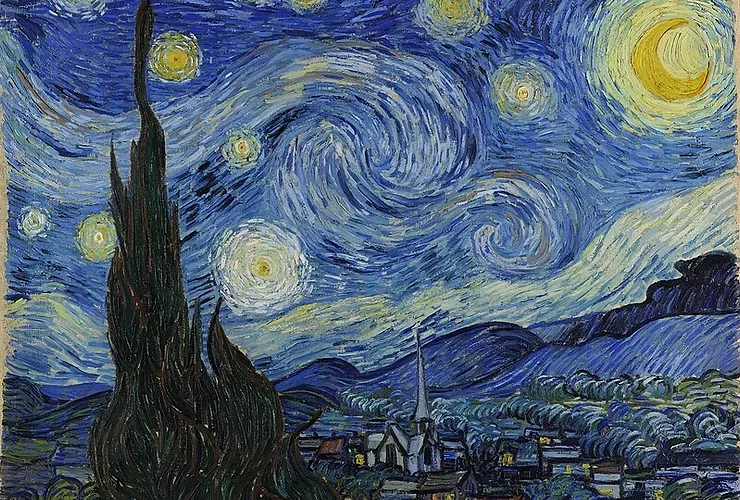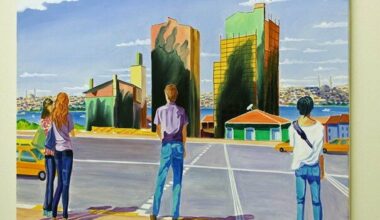Vincent van Gogh’s artistic journey was heavily influenced by his brother Theo, who encouraged him to explore landscape painting in exchange for financial support. Although Van Gogh occasionally struggled with technique, his works consistently displayed a deep appreciation for natural beauty and the vibrant contrasts of color.
Van Gogh often included figures in his landscapes to move beyond traditional depictions of nature and to highlight the connection between humans and the environment—a theme evident in his painting of blooming hyacinths.
Corn Harvest in Provence
When Van Gogh settled in Provence in 1888, he was captivated by the region’s vibrant colors and agricultural life. This admiration is evident in many of his works from this period, characterized by his signature bold brushwork and expressive use of color.
Van Gogh’s time in Provence was one of extraordinary creativity. He produced hundreds of paintings and sketches, wrote numerous letters describing his surroundings, and used his art as an emotional outlet.
Corn Harvest in Provence is one of Van Gogh’s many landscape paintings that captures the idyllic scenes of the French countryside. This work showcases his experiments with flat areas of color, bold outlines, and varying brushstrokes to add texture. Van Gogh’s thick application of paint adds a tactile quality to the painting, enhancing its overall impact.
The painting depicts a half-harvested wheat field, with reapers working in the background. Van Gogh’s goal was to capture and convey the beauty of nature. Initially, he created a watercolor study of the scene, which he sent to his sister Wil at Harvard Art Museums. In the final oil painting, Van Gogh altered certain elements, notably raising the viewpoint to better focus on the cornfields.
The Starry Night
The Starry Night is one of Van Gogh’s most famous works, created during his time in an asylum in Saint-Remy. Unable to paint outdoors, Van Gogh relied on his imagination and memory to capture the power of nature in this nocturnal scene. The painting is a departure from the Impressionist techniques he encountered in Paris; instead of clear brushstrokes, Van Gogh used contoured strokes to convey emotion and energy.
Although the work is somewhat abstract, Van Gogh used intense, contrasting colors to create a sense of motion. The swirling blues of the sky and the windswept cypress tree suggest a dreamlike landscape. While Van Gogh was not strictly an Impressionist, his use of color to depict light and atmosphere was influenced by artists like Monet and Seurat. The Starry Night is a poignant reflection of Van Gogh’s struggle with mental illness and remains one of his most celebrated works.
Sunflowers
Vincent van Gogh had a deep affection for sunflowers, painting them extensively throughout his career. Each of his sunflower paintings depicts different stages of the flower’s life cycle, from young buds to full bloom and eventual decay. Van Gogh used a range of yellow, orange, and green hues to capture their beauty.
In one of his sunflower paintings, Van Gogh employed various shades of yellow and contour lines to create a striking contrast. The painting features fifteen sunflowers against a lighter background, with some of the flowers losing their petals while others begin to fade. This careful juxtaposition of yellows adds depth and dimension to the work.
As with many of his landscapes, Van Gogh painted most of his sunflower works outdoors before refining them in his studio. He aimed to achieve a harmonious balance between brushstrokes and colors, seeking to make his paintings vibrant and lifelike.
Van Gogh’s palette for the sunflower series consisted largely of primary colors. To achieve the vibrant yellow hues, he mixed sensitive yellow paint with orange lead, an intensely yellow-orange pigment. After Van Gogh’s death, his brother Theo displayed one of the sunflower paintings above his sofa, alongside The Harvest, making it one of the most beloved Van Gogh landscapes.
Vincent van Gogh did not primarily consider himself a landscape painter, but he often used this genre to express his thoughts on life and death. He believed in the deep connection between people and nature, a theme he explored through his depictions of wheat fields, trees, and other natural elements that symbolize the cycle of life.
Even though Van Gogh was living in the Netherlands when he created his coastal scene paintings, his approach evolved significantly when he moved to France. Influenced by the Impressionists, his style transformed from dark, Realist tones to brighter, more vibrant hues, as seen in his only coastal scene painting, which contrasts the rough seas with a threatening sky. This painting was stolen in 2002 and later recovered in Naples, Italy, with some damage, including a missing chip in the lower left-hand corner.
Van Gogh’s ability to convey emotion and atmosphere through his landscapes has left a lasting impact on the art world, making him one of the most celebrated artists of all time.







